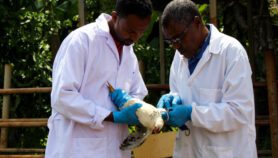By: Siobhan Chan
Send to a friend
The details you provide on this page will not be used to send unsolicited email, and will not be sold to a 3rd party. See privacy policy.
Scientific research bodies in the developing world are less likely to encourage public participation with science than their developed world counterparts, a report has found.
Sarah Palmer and Renato Schibeci, writing in Public Understanding of Science on 24 August, examined the requirements of science research funding bodies from Africa, the Americas, Asia, Europe and Oceania, over the period 2004–2011.
They found that the majority of countries were focused on educating the public rather than engaging with them. In particular, funding organisations in developing nations were less likely to encourage community participation.
The researchers identified a spectrum of types of science communication, ranging from the ‘deficit model’ — the primary form of science communication, since 1985, where scientists educate the public about their findings — to a more ‘deliberative’ approach, where the public set the research agenda and are involved throughout.
They then analysed funding organisations’ public engagement policies by looking at their guidelines and websites, and gleaned additional information on the public engagement status and activities of national organisations from external websites.
The deficit model is still the most common form of communication, the authors found.
But in developed countries, there has been a gradual realisation that the public also has valuable knowledge to share, and that the focus should be more on participation.
Organisations doing this particularly well include the Wellcome Trust, in the United Kingdom, the European Commission’s FP7 (Seventh Framework Programme), and Australia’s National Health and Medical Research Council.
"Developing countries seem to follow the deficit model more than the developed world," Schibeci, associate professor of science education at Murdoch University, Australia, told SciDev.Net.
"In China and Latin America, there seems to be a mantra of ‘educating the public’, which often means transmitting knowledge. But it’s the public who have to live with the consequences of scientific decisions."
Schibeci said that scientists are often reluctant to engage with the public because of a lack of time, skills and rewards — such as recognition from their peers and ease of obtaining funding for further projects. However, he said, they must realise that communicating their work "is not the icing on the cake, but part of the cake".
International funding bodies are bringing about big changes, however. One example is the International Foundation for Science (IFS), which requests that grant applicants must explain how the research will fit in with "the environmental and socio-economic conditions in the region" and how they will "make their results available to local stakeholders, such as farmers and local industry".
Graham Haylor, director of the IFS, said that public engagement in developing countries will "not only build their capability as scientists, but also increase their agency through widespread engagement as equals with farmers, entrepreneurs and policymakers [rather than above them, as implied by the deficit model]".
Ruth Ladenheim, secretary of planning and politics in science, technology and productive innovation of the Argentinian Ministry of Science, Technology and Productive Innovation (MINCYT), said that public engagement is a novel concept for many developing countries but that this "does not mean that their … engagement is poor compared to developed countries".
Ladenheim said that Argentina has been engaging the public with science with a "conviction" previously unseen and cited TECNOPOLIS, a public science, technology and innovation exhibition; TEC TV, the first Latin American television channel dedicated to science and technology; and an annual innovation contest that allows even non-scientists to take part.
References
Public Understanding of Science doi: 10.1177/0963662512455295 (2012)













